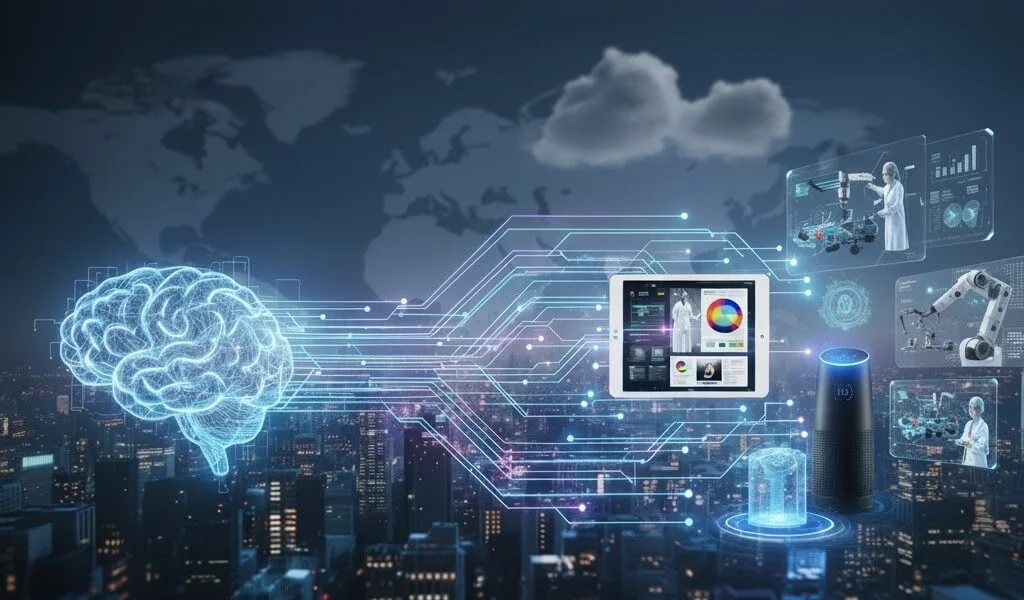Table of Contents
Listen to article
Generative AI has emerged as both a trend and a solution for companies trying to keep up with today’s fast-moving digital world. Why?
Because generative AI and other technologies can automate tasks that absorb 60 to 70% of employees’ time, helping companies cut busywork, increase productivity, and focus on their core business functions.
It should come as no surprise, then, that generative AI development services are in high demand, not only to build new models but also to integrate them seamlessly into everyday workflows.
Today, we’re focusing on the importance of generative AI integration—the process of embedding generative AI capabilities into existing applications and infrastructures to create measurable operational impact.
Keep reading to explore common generative AI use cases, best practices, top AI integration companies in 2025, and more.
What is generative AI?
Generative AI refers to systems built on large foundation models capable of producing new text, images, audio, or code based on patterns learned from vast datasets. Beyond simple content generation, it helps businesses streamline operations, enhance user experiences, and uncover new efficiencies across areas like research, marketing, and artificial intelligence product development.
What is generative AI integration?
Generative AI integration is the process of embedding generative AI capabilities into existing business systems, applications, and workflows. As part of the AI life cycle, this process involves assessing business needs, connecting AI to existing systems, fine tuning models, training staff on how to use new tools, and continuously optimizing performance.
In addition to understanding what is AI integration, companies need a comprehensive AI integration strategy to reduce the risk of wasted resources, delayed decision-making, and a poor customer experience, making it a critical part of AI adoption.
Top 5 Generative AI Use Cases & Trends
Generative AI development and integration are being leveraged by an array of industries, each with different use cases and goals. This includes:

Healthcare
In healthcare, generative AI solutions can improve efficiency, reduce administrative burdens, and enhance patient engagement. In a survey of healthcare leaders, 85% of respondents were exploring or had already adopted gen AI capabilities, with the greatest potential seen in increasing administrative efficiency and clinical productivity.
While careful integration is needed to address concerns regarding accuracy, ethical use, and clinical safety, responsible integration into healthcare could mark a shift toward more proactive, precise, and patient-centered systems.
Use case: Generative AI can be used to generate insightful narrative reports, as well as power voice assistants, medical copilots for healthcare providers, AI chatbots for patient communication, and other LLM-powered features—thereby streamlining processes for healthcare professionals.
Scopic Case Study:
Scopic’s work with Mediphany illustrates how generative AI integration is transforming healthcare. By embedding speech-to-text technology and large language models directly into Mediphany’s existing desktop application, radiologists can now generate structured, real-time reports from spoken input. The integrated system achieves high levels of accuracy, significantly reducing manual documentation time—freeing specialists to focus on diagnostics and patient care.
This type of generative AI integration shows how healthcare providers can enhance accuracy, reduce administrative burdens, and accelerate clinical workflows without overhauling their existing infrastructure.

Customer Service
From drafting emails to providing real-time transcription and analytics, generative AI is transforming customer service as we know it. Among its many applications, one of the most recognized is its use in customer-facing AI chatbots.
Generative AI-driven chatbots can understand complex questions, provide more personalized responses, and hold more natural conversations, thereby improving the overall customer experience. And with 71% of consumers expecting companies to deliver personalized interactions, integrating generative AI has proven to be an effective way to meet rising expectations.
Use case: In e-commerce, a generative AI chatbot can guide shoppers through product recommendations based on their preferences, past purchases, or browsing history. It can also answer questions in real time, making the shopping experience smoother and more personalized.

Finance
Generative AI has demonstrated significant potential in enhancing financial analytics, improving decision-making processes, and generating synthetic financial data for various applications.
In fact, banking is expected to capture an annual $200–$340 billion in value from generative AI, largely through significant productivity gains. However, AI integration consulting is especially important in this industry, as data security breaches, noncompliance, and biased decision-making are all large concerns.
Use case: In financial institutions, generative AI can be integrated into existing apps—such as CRMs, portfolio management systems, and customer-facing software—and used to automate report generation, summarize data, analyze customer data, and more.

Software Development
Generative AI improves the software development life cycle by automating tasks, improving the quality of the end product, and reducing time to market. For developers, generative AI has become a key tool for coding, as it suggests code snippets, helps on debugging issues, and even generates entire functions or scripts based on natural language prompts.
It’s important to note that generative AI implementation is not meant to replace developers but rather enhance their abilities. To learn how AI is transforming development teams and workflows, watch our recent podcast.
Use case: By integrating generative AI into development environments and project management tools, software teams can automate code reviews, generate test cases, and document APIs automatically. These same integrations also allow LLMs to generate production-ready code snippets or entire feature modules from natural language prompts—such as building dashboards, authentication systems, or data connectors.

Manufacturing
Generative AI enhances productivity, quality control, predictive maintenance, supply chain optimization, customization, and sustainability in manufacturing. Experts in generative AI ensure seamless generative AI integration by mapping business needs, customizing models, and aligning new capabilities with existing systems, so manufacturers see measurable efficiency gains.
Google Cloud identifies five use cases for manufacturers to get started with generative AI:
- Machine-generated event monitoring
- Customer service automation
- Document search and synthesis
- Product and content catalog discovery
- Supply chain advisor
Use case: Manufacturers are integrating generative AI into CAD and product lifecycle management (PLM) systems to automatically generate design prototypes, simulate performance, and optimize material usage before production. When connected with IoT and predictive maintenance tools, these models can analyze sensor data to forecast equipment issues and suggest preventive actions.
This level of generative AI technology integration helps reduce downtime, cut material waste, and accelerate time to market.

How to Approach Generative AI Integration: Best Practices
Integrating generative AI into your system may seem intimidating, but with the right guidance, the process can be clear and achievable. Keep reading for tips on how to integrate generative AI into your business processes.
Have a Clear Understanding of Your Goals
Successful generative AI technology integration starts with defining clear business goals. For instance, do you want to create more personal user experiences, automate processes, or create a tool that assists with diagnoses?
Since different goals require different strategies, having a clear understanding of what you’re looking for helps your integration partner create a plan that’s tailored, effective, and aligned with your business priorities.
Prioritize Scalability
You can’t just create a solution that works today; you have to consider your future business needs. If your generative AI solution can’t adapt to a larger user base and greater volumes of data, you risk bottlenecks, rising costs, and a system that quickly becomes outdated.
As you embark on your AI business integration journey, make sure you partner with a custom AI development company that designs for scalability from the start—using modular architecture, containerized deployment, and cloud-native infrastructure. These approaches make it easier to scale your generative AI systems as user demand and data volumes grow, without disrupting existing operations.
Adopt a Security-First Mindset
Whether your company uses generative AI to handle sensitive patient data, help customers choose products, or provide financial advice, security should be your number one priority.
For secure generative AI API integration, apply end-to-end encryption, role-based access control, and secure data pipelines to protect both training and inference data. You should also identify potential vulnerabilities, perform regular security audits, and follow compliance standards such as GDPR and HIPAA when handling sensitive information.
This helps you prevent cyberattacks, data breaches, and other security incidents, thereby strengthening customer trust in your company.
Leverage Vendor Expertise
Don’t worry, you’re not alone when it comes to generative AI integration. With generative AI integration services, you can successfully embed advanced technologies into your everyday operations, addressing concerns like scalability, security, and system compatibility.
That said, it’s important to choose an AI development company with generative AI expertise, industry-specific experience, and a proven track record of success.
Plan for Training & Change Management
While there are many benefits of generative AI integration, your team needs to be prepared for changes in workflows to ensure a smooth transition. Getting your whole company involved in new changes is key to successful adoption, with hands-on workshops, clear documentation, and ongoing support helping employees during this transition.
In fact, research backs up this claim, stating that large-scale tech transformations succeed when more employees are involved. While only 2% typically participate, companies that engage at least 7% double their odds of positive shareholder returns, with the best results seen when 21–30% of employees are included.
Top Generative AI Integration Companies in 2025
We recently wrote an article on the top AI integration companies, where we compared their core strengths and ratings to help businesses choose the right partner.
Now, we’re narrowing our search even further to highlight companies that specialize in generative AI integration services.
| Company | Core Strengths | Rating (Clutch) |
| Scopic | Strategic AI Consulting, AI Development and AI Integration services; proven track record in AI solutions; Seamless deployment into existing business workflows; industry-leading secure, scalable, and cost-efficient solutions |
4.9/5 |
| Simform | Cloud, data, AI/ML, and experience engineering for seamless digital experiences | 4.8/5 |
| STX Next | Designing and building modern data platforms and AI-powered applications | 4.7/5 |
| BlueLabel | Using generative AI to unlock practical, transformative solutions | 4.7/5 |
| HatchWorks AI | Helping clients unlock AI’s value through the power of data | 4.9/5 |
| InData Labs | Helping organizations of all sizes create intelligent products | 4.9/5 |
| Plavno | Identifying AI opportunities and creating roadmaps for implementation | 4.9/5 |
Scopic’s Expertise in Generative AI Integration
At Scopic, innovation is built into everything we do—from web, mobile, and desktop development to advanced AI and generative AI integration. With nearly two decades of experience across industries, we design scalable software ecosystems that move beyond prototypes to production-ready solutions.
Our team combines full-stack development, data engineering, and model integration to embed AI capabilities seamlessly into clients’ existing platforms and workflows.
Take our work with Talking Anya, for example. To increase engagement, the founders partnered with us to create a more interactive experience for their children’s app. Using tools like ChatGPT and AI-based speech synthesis technology, Scopic helped them create a more realistic playtime experience, which enhanced user interaction capabilities, improved security, and increased downloads.
Similarly, with Codeaid, Scopic integrated natural language processing and real-time evaluation features into its AI Interviewer tool, helping recruiters automate and streamline candidate assessments.
These projects reflect the depth of our AI and generative AI integration services, helping clients across healthcare, HR tech, education, and many more to unlock automation, personalization, and measurable efficiency—all without disrupting their existing systems.
Explore more results in our portfolio and case studies.
Final Thoughts
The global generative AI market is projected to expand at a compound annual growth rate of 36.99% from 2025 to 2031. As generative AI integration increasingly becomes the norm, companies that don’t adopt new technologies are at risk of falling behind their competitors.
At Scopic, our AI integration services help you successfully introduce generative AI into CRMs, ERPs, or cloud platforms without interrupting your everyday operations.
If you’re interested in exploring how AI can enhance your business operations, schedule a free consultation with our team today.
FAQs about Generative AI Implementation
What is generative AI integration?
Generative AI integration is the process of embedding generative AI capabilities—such as text, image, or speech generation—into existing business systems, applications, and workflows.
How much does AI integration cost?
The cost of AI integration varies widely depending on factors such as project scope and system complexity. For a tailored quote, schedule a free consultation today.
What are the main benefits of generative AI integration?
The benefits of generative AI integration include automation of repetitive tasks, faster decision-making, greater personalization, and improved customer service—leading to higher productivity and efficiency across teams.
How long does generative AI integration take?
The timeline for developing and deploying our generative AI services and solutions varies depending on the complexity of your project and your specific requirements. However, our experienced team works efficiently to deliver high-quality results on schedule, ensuring your project is completed within a reasonable timeframe.

About Generative AI Integration Guide
This guide was authored by Baily Ramsey, and reviewed by Isadora Müller, Business Development Manager at Scopic.
Scopic provides quality and informative content, powered by our deep-rooted expertise in software development. Our team of content writers and experts have great knowledge in the latest software technologies, allowing them to break down even the most complex topics in the field. They also know how to tackle topics from a wide range of industries, capture their essence, and deliver valuable content across all digital platforms.





